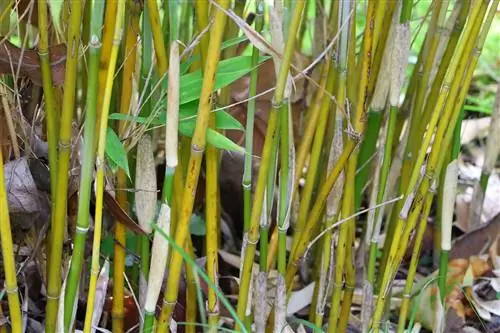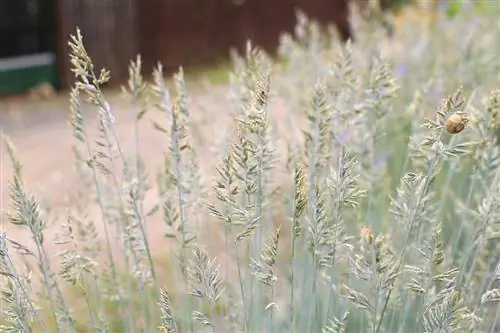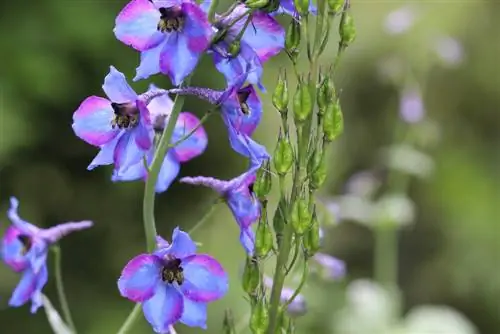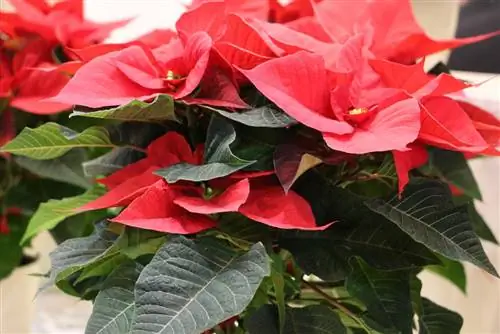- Author admin [email protected].
- Public 2023-12-17 03:39.
- Last modified 2025-01-24 12:45.
Rock gardens can also be created on slopes, hard-to-reach and dry places in the garden. In these locations, wildflowers and succulents are ideal rock garden plants because they are usually hardy, very adaptable and easy to care for. Level or easily accessible rock gardens can be planted with a little more effort. But here too, the plants must be perfectly adapted to their location, because a rock garden usually has very dry and full sun conditions. Not all plants are equally suitable, but there is a surprisingly large number of shrubs, perennials and grasses to choose from.
Plant selection
The motto in the rock garden is: less is more. The planting should not be too dense. It is better to set accents with loose planting. Instead of many different plants, larger groups of the same plants look better. When selecting the individual rock garden plants, the size of the rock garden and its location are crucial. Since robust, winter-hardy garden plants should primarily be used when designing a rock garden, all cultivated varieties of rock garden plants from the mountain areas of Germany, Italy, Austria, Switzerland and France are particularly recommended.
Conifers and evergreens
For larger rock gardens, trees serve as eye-catchers. Coniferous trees are particularly easy to care for and do not lose their shine and color even in winter. Depending on the size of the rock garden, upright-growing, taller forms up to a height of around 2.5 meters or bushy-growing shrubs are suitable.
Dwarf conifers
Low-growing conifers also fit into small rock gardens or in the front of large areas. Some almost crawl along the ground and do not naturally grow very tall, so pruning is not necessary.
- Dwarf spruces, for example the blue hedgehog spruce (Picea glauca 'Echiniformis')
- dwarf hemlocks (Tsuga canadensis), special forms have 'Glauca', 'Nana' or 'Jeddeloh'
- Dwarf pines: Dwarf ball pines such as Pinus mugo 'Alpenzwerg' or 'Mops'
- Dwarf firs: Dwarf balsam fir (Abies balsamea 'Nana') or dwarf Colorado fir (Abies concolor 'Compacta')
- Dwarf juniper: Creeping juniper (Juniperus procumbens 'Nana')
- Dwarf cypresses: Hinoki cypress (Chamaecyparis obtusa 'Nana Gracilis'), Sawara cypress (Chamaecyparis pisifera 'Nana') or the flat-spherical mini cypress (Chamaecyparis pisifera 'Sungold')
Conifers up to 2.5 meters tall
Slender, columnar conifers are particularly suitable as background plants in a rock garden. They form a harmonious transition to house walls, walls or high fences or appear as green sculptures that attract the viewer's eye. And not just in summer, but all year round.
- Hanging blue cedar (Cedrus libani 'Glauca Pendula')
- Mediterranean cypress (Cupressus sempervirens 'Stricta')
- Columnar juniper (Juniperus communis 'Sentinel')
- Rocket juniper (Juniperus scopulorum 'Blue Arrow') also called Green Arrow
- Dwarf mussel cypress (Chamaecyparis obtusa nana “Gracilis”)
Low-growing bushes, shrubs and trees
If the soil in the rock garden is a little richer in humus, evergreen rhododendrons, azaleas or various types of maple can also be used. The rock garden plants require a slightly richer soil, so very sandy garden soil is best treated with compost before planting.
- Azaleas: Greenwood or North Tisbury hybrids
- Blue rue (Perovskia abrotanoides): height 50 to 100 cm
- Boxwood (Buxus): for example microphyllo 'Faulkner', in moderately moist areas or partially shaded
- Fan maple (Acer palmatum): only summer green
- Rock Daphne (Daphne petrae): flowering ground cover shrub, height about 10 cm
- Japanese maple (Acer japonicum): summer green
- Lavender (Lavandula): growth height 30 to 80 cm (depending on the variety)
- Laurel loquat (Photinia) like Photinia fraseri 'Red Robin' (purple loquat)
- Rhododendron: Hybrids like 'Patty Bee' and 'Too Bee'
Perennials
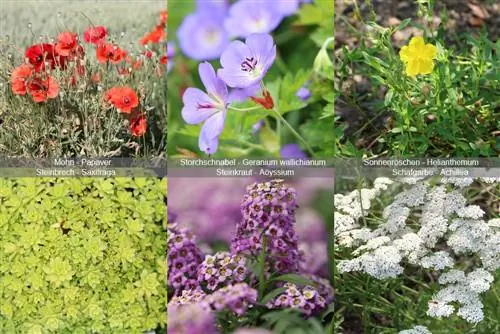
Instead of planting annual rock garden plants, perennials require significantly less care. There is something for every taste here.
Spring bloomers
These perennials usually bloom from around the end of April until June.
- Alpine asters (Aster alpinus): growth height up to 20 cm
- Bergenia (Bergenia): height 30-40 cm, wintergreen foliage, partial shade
- Globular flowers (Globularia): wintergreen, height 20-40 cm
- Poppy seeds (Papaver): 30-70 cm height depending on the variety
- Storksbill (Geranium): clumpy growth up to 40 cm high
- Sunflower (Helianthemum): clump-forming, wintergreen, growth height up to 15 cm
- Saxifrage (Saxifraga species): evergreen creeping plant
- Stonewort (Alyssum saxatile, Aurinia saxatilis): small plant, ideal for narrow gaps
- Seagrass (Armeria maritima): dark foliage, looks good on light stones
Summer bloomers
Summer-flowering plants and perennials produce their first flowers in June. Some species decorate the rock garden with their flowers until August.
- Alpine edelweiss (Leontopodium alpinum): 15-20 cm height, calcareous soil
- Gold droplet (Chiastophyllum oppositifolium): evergreen perennial, growth height up to 20 cm, likes shady locations, yellow flowers
- Yarrow (Achillea millefolium): various cultivation forms, up to 70 cm tall
- Silver thistle (Carlina acaulis): perennial, herbaceous plant with growth heights of up to 50 cm
- Thyme (Thymus): blooms persistently in white to purple, height up to 30 cm
Late blooming perennials
The rock garden also needs a few highlights for late summer and autumn. You can set late accents with these rock garden plants:
- Penstemon barbatus: growth height up to 100 cm, wintergreen
- Rock fat leaf (Sedum cauticola 'Ruby Glow'): chimney red flower, height up to 40 cm
- Gold daisy (Buphthalmum salicifolium): yellow flowers, up to 40 cm tall
- Autumn saxifrage (Saxifraga cortusifolia var. fortunei 'Rokujo'): creeping growth habit
- Autumn gentian (Gentiana sino-ornata 'White Mountain'): low-growing cushion plant
Continuous bloomers
Of course, the easiest ones are to use perennials that bloom permanently from spring to autumn. The following varieties bloom from the beginning of June until September at the latest:
- Bluebells (Campanula carpatica, Carpathian bellflower): perennial and undemanding, height about 30 cm
- Catnip (Nepeta): scented plant, growth height up to 30 cm
- Wallflower (Cinnamonwort, Cymbalaria muralis): also ground cover, growth height up to 15 cm, white or light purple flowers
- Midday flower (Delosperma): cushion-forming plant, low-growing, very colorful flowers
- Cloves (Dianthus alpinum or freynii): cushion-forming, permanent bloomers in many colors, fragrant
- Soapwort (Saponaria): permanently flowering, clump-forming perennial, growth heights up to 40 cm
Ground cover perennials
Cushion perennials or ground cover plants spread well in all directions over time. This makes the rock garden look very natural. That's why they definitely shouldn't be missing from a rock garden.
- Common bitterroot (Lewisia cotyledon): rosette-like plant with flowers in May to June, succulent, evergreen
- Houseleek (Sempervivum): rosette-shaped, succulent ground cover, well drought-resistant
- Blue cushions (Aubrieta forms): blue-violet flowers
- Dachwurz (Sempervivum hybrids): thick-leaved rosette perennial with flowers in June/July, 10-15 cm tall
- Hornwort (Cerastium tomentosum var. columnae): silvery-white foliage, white flowers in May to June
- Felty hornwort: silvery-white, small leaves, does not bloom, but provides wonderful color accents
- Cat's paw (Antennaria dioica): velvety, hairy, silvery foliage, flowers in May/June
- Man's Shield (Androsace): biennial plant, flowers in April to June
- stonecrop (sedum, sedum): slightly succulent ground cover, flowering period June to August
- Titleflower (Iberis): evergreen cushion plant, blooms in April to May
- Stone balsam (Alpine balsam, Erinus alpinus): cushion-forming alpine herb, blooming for a long time (April to July)
Wildflowers
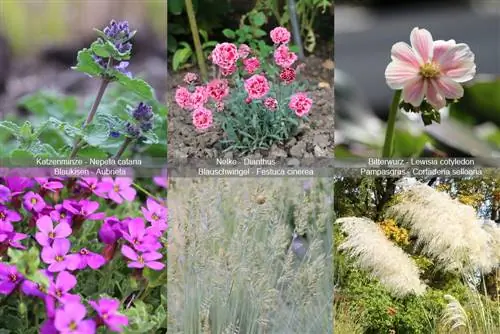
Wildflowers have proven successful on slopes or in wall-shaped rock gardens, especially those that originally come from regions with a similar climate. Not only are they easy to care for, but they also give the slope a very natural look.
Wildflower seeds for sunny areas are available in stores everywhere. The seeds are best scattered in autumn:
- Cornflowers (Cyanus segetum)
- Daisies (Leucanthemum), especially poor meadow daisies
- Poppies (Papaver)
- Feverfew (Tanacetum parthenium)
- Black-eyed Susan (Thunbergia alata), annual climbing plant
- Sunflower (Helianthemum)
Ornamental grasses
In the rock garden, ornamental grasses provide structure and give it a flowing, soft ambience. Many of these ornamental grasses grow very bushy and have long flower spikes. Others impress with their extravagant foliage color. Even in autumn, grasses with their orange-red, yellow or purple stalks provide accents. Although grasses are basically perennial plants, they deserve a separate mention. When it comes to grasses, there are also wintergreen species that provide highlights all year round.
- Bear grass (Xerophyllum tenax): not actually a grass in the botanical sense, but a germinium plant, forms pretty, white flowers, grows to a height of over 1.2 m
- Bearskin grass (Festuca scoparia): greenish-bluish foliage, wintergreen and well hardy, for particularly dry rock garden areas
- Blue-green iridescent grass (Koeleria glauca): evergreen ornamental grass, hardy
- Blue fescue (Festua glauca): spherical, cushion-like growth with heights between 20 and 40 cm, very robust and frost-hardy, blue-green leaves, wintergreen
- Bronze Schmiele (Deschampsia cespitosa 'Bronze Veil'): only summer green, winter hardy
- Pennisetum alopecuroides 'Compressum'): evergreen, hardy ornamental grass
- Pampas grass (Cortaderia selloana): growth heights up to 2 m, huge flower fronds, hardy
- Golden beard grass: blue to gray foliage, orange to violet color in autumn, height
Conclusion
No matter how well planned a rock garden is, it only gets its special charm through the right plants. Bushes or conifers are particularly effective as eye-catchers in the background. Flowering perennials and ground covers provide pops of color and work well in combination with grasses. A significant number of plants are ideally suited to the rather inhospitable conditions in the rock garden.
Tips for speed readers
- evergreen trees as an eye-catcher for the background
- flat-growing conifers for transition or small systems
- flowering sub-shrubs or colorful perennials provide contrasts and variety
- It is better to plant groups of a few species instead of many individual plants
- always plant very loosely
- Perennial bloomers and flowering ground cover plants are particularly attractive
- Perennials that bloom in fall usher in winter
- incorporate grasses to loosen things up
- wintergreen grasses provide color in the dreary season
- small perennials and wildflowers are suitable for walls and joints
- There are also suitable rock garden plants for shady areas


